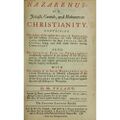Difference between revisions of "Category:Gospel of Barnabas (text)"
| Line 21: | Line 21: | ||
====Editions==== | ====Editions==== | ||
The first known reference to the Spanish ms. of the Gospel of Barnabas goes back to 1634 in Morisco manuscript BNM MS 9653 in Madrid, written by Ibrahim al-Taybili in Tunisia. "Gospel of Saint Barnabas where one can find the light" ("y así mismo en Evangelio de San Bernabé, donde se hallará la luz"). The Spanish ms. is then briefly mentioned in the printed edition of De religione | The first known reference to the Spanish ms. of the Gospel of Barnabas goes back to 1634 in Morisco manuscript BNM MS 9653 in Madrid, written by Ibrahim al-Taybili in Tunisia. "Gospel of Saint Barnabas where one can find the light" ("y así mismo en Evangelio de San Bernabé, donde se hallará la luz"). The Spanish ms. is then briefly mentioned in the printed edition of De religione Mohammedica by [[Adriaan Reland]] in 1717. | ||
The first detailed description of the Italian ms of the Gospel of Barnabas is offered in 1718 by [[John Toland]]. Both the Italian and the Spanish ms. are referred to in 1734 by [[George Sale]] in his English edition of Qur'an. | The first detailed description of the Italian ms of the Gospel of Barnabas is offered in 1718 by [[John Toland]]. Both the Italian and the Spanish ms. are referred to in 1734 by [[George Sale]] in his English edition of Qur'an. | ||
Revision as of 11:27, 30 July 2014
The Gospel of Barnabas (see [ Online Text]) is an "apocryphal" gospel.
The ancient Gospel of Barnabas
An ancient Gospel of Barnabas is mentioned in two independent lists of apocryphal work: the Latin Decretum Gelasianum (6th century), as well as the Greek List of the Sixty Books (7th-century). No extant portions or fragments of the document have been preserved.
The medieval Gospel of Barnabas
Manuscript tradition
A Gospel of Barnabas is attested by two late-16th-century manuscripts, one in Italian, one in Spanish. The relation between the two manuscripts is unclear; Istanbul is likely to be the place of origin of both manuscripts.
- The Italian manuscript belonged to John Frederick Cramer who in 1709 lent it to John Toland. The manuscript was transferred to the Austrian National Library in Vienna in 1738.
- The Spanish manuscript is now lost, its text surviving only in a partial 18th-century transcript, discovered in the 1970s at the University of Sydney's Fisher Library among the books of Charles Nicholson.
Editions
The first known reference to the Spanish ms. of the Gospel of Barnabas goes back to 1634 in Morisco manuscript BNM MS 9653 in Madrid, written by Ibrahim al-Taybili in Tunisia. "Gospel of Saint Barnabas where one can find the light" ("y así mismo en Evangelio de San Bernabé, donde se hallará la luz"). The Spanish ms. is then briefly mentioned in the printed edition of De religione Mohammedica by Adriaan Reland in 1717.
The first detailed description of the Italian ms of the Gospel of Barnabas is offered in 1718 by John Toland. Both the Italian and the Spanish ms. are referred to in 1734 by George Sale in his English edition of Qur'an.
The editio princeps of the Italian ms appeared in 1907 in a translation by Lonsdale and Laura Ragg. The Raggs' English version was quickly re-translated into Arabic by Rashid Rida, in an edition published in Egypt in 1908.
Content
The Gospel of Barnabas contains a harmony of the four Canonical Gospels, but is strongly anti-Pauline and anti-Trinitarian in tone. In accordance with Islamic doctrine, Jesus is described of a prophet and his divinity is denied. The text also claims that Jesus escaped the crucifixion and Judas Iscariot was crucified in his place. Finally, Jesus predicted the coming of Mohammad.
The document however contains many details that are not in line with the Qur'an. Notably, in the Gospel of Barnabas Jesus denies that he was the Messiah.
Contemporary controversies
The document has been used in Muslim apologetics as evidence that the "original" Gospel of Jesus before its "corruption" conformed to the Islamic interpretation. The Gospel of Barnabas however is a 14th-17th century work and no connection has been proven between it and the ancient Gospel of Barnabas mentioned in earlier sources.
Pages in category "Gospel of Barnabas (text)"
The following 2 pages are in this category, out of 2 total.
Media in category "Gospel of Barnabas (text)"
The following 12 files are in this category, out of 12 total.
- 1718 Toland.jpg 500 × 500; 135 KB
- 1907 Ragg.jpg 267 × 400; 30 KB
- 1907 Sa`adah - Rida.jpg 667 × 951; 114 KB
- 1977 Cirillo - Fremaux.jpg 800 × 1,200; 33 KB
- 1984 Sox.jpg 322 × 500; 54 KB
- 1985 Yusseff.jpg 325 × 500; 54 KB
- 1989 Campbell.jpg 375 × 500; 36 KB
- 1990 Yusseff.jpg 1,610 × 2,527; 717 KB
- 1991 Giustolisi - Rizzardi.jpg 351 × 500; 44 KB
- 1995 Bernabe-Pons.jpg 355 × 499; 12 KB
- 1998 Bernabe-Pons.jpg 934 × 1,404; 270 KB
- 2018 Martinelli.jpg 354 × 499; 20 KB











